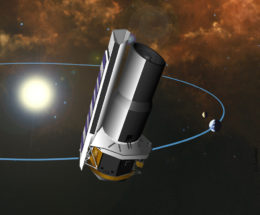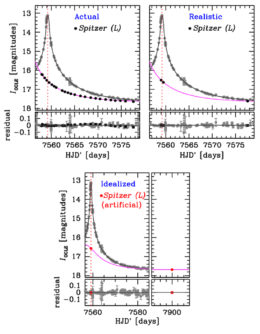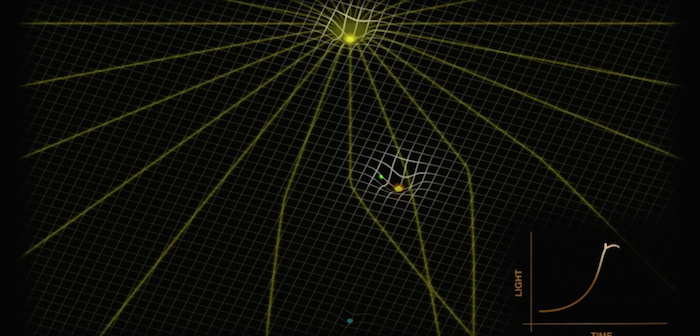The gravity of massive galaxies can warp the light from distant background sources into dramatic shapes. Gravitational lensing by foreground stars, planets, and other low-mass objects may be less visually stunning, but these tiny lensing events hold big promise.

The Spitzer Space Telescope, shown in this artist’s impression, trails Earth at a distance of over 1 AU. The large distance between Spitzer and ground-based observatories makes it a good choice for carrying out microlensing measurements. [NASA/JPL-Caltech]
Multifaceted Microlensing
When light from a distance source is bent by an object passing through our line of sight, we observe a temporary brightening of the source — a gravitational microlensing event.
While microlensing may be best known as a method of discovering exoplanets, it has the potential to detect other types of astrophysical objects as well. Most notably, microlensing can reveal faint, isolated objects that wander into our line of sight: rogue planets that have been ejected from stellar systems, brown dwarfs, and compact stellar remnants like neutron stars. Microlensing may also help us learn about the enigmatic population of stellar-mass black holes, which seem to be curiously rare between two and five solar masses.
Like many promising astrophysical techniques, microlensing comes at a cost: lots of telescope time, be it ground-based, space-based, or a combination of the two. Is it possible to take advantage of this powerful technique in a less costly way?

Light curves and best-fit model curves for actual, realistic, and idealized data sets. The grey symbols are the ground-based observations. Click to enlarge. [Adapted from Shin et al. 2018]
Putting It to the Test
In order to determine the properties of the lensing object, you need to first determine the microlens parallax by comparing observations taken at different times of the year (annual parallax), at different ground-based observatories (terrestrial parallax), or simultaneously at ground- and space-based observatories (space-based parallax). A team led by In-Gu Shin (Harvard-Smithsonian Center for Astrophysics) tested the idea that the space-based microlens parallax can be determined accurately from just a handful of observations.
In order to test this theory, Shin and collaborators paired ground-based observations of OGLE-2016-BLG-1045, a microlensing event discovered by the Optical Gravitational Lensing Experiment (OGLE), with space-based observations from the Spitzer Space Telescope.
The authors considered three cases derived from the Spitzer observations:
- “Actual” case: the existing Spitzer measurements, which span roughly 15 days
- “Realistic” case: two space-based observations near the time of the ground-based peak and one baseline observation
- “Ideal” case: one space-based observation at the moment the ground-based peak occurs — a moment that’s nearly impossible to capture under normal circumstances — and one baseline observation taken well after the microlensing event

The lens mass and distance derived from the realistic, actual, and idealized data. The two rows represent the results for the two degenerate solutions. For both parameters, the realistic result is within 1σ of the actual result. Click to enlarge. [Shin et al. 2018]
Getting to Know OGLE-2016-BLG-1045
By modeling the light curves for each of the three cases, the authors find that OGLE-2016-BLG-1045 is a low-mass stellar object (0.08 solar masses) located 16,000 light-years away. The results from the “realistic” and “actual” cases agreed to within 1σ, confirming that just two or three observations can adequately constrain the properties of the lensing object.
This promising result hints that it may be possible to study a large sample of isolated objects with just a few measurements each, helping us to understand better the populations of brown dwarfs, stellar remnants, and black holes in our galaxy. Expect to see more exciting results from microlensing in the future!
Citation
I.-G. Shin et al 2018 ApJ 863 23. doi:10.3847/1538-4357/aacdf4

